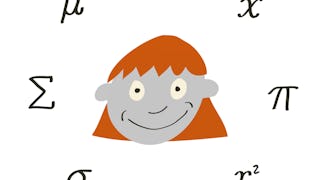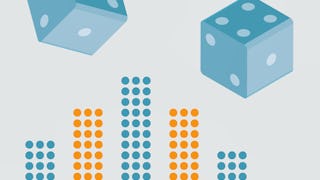Stanford's "Introduction to Statistics" teaches you statistical thinking concepts that are essential for learning from data and communicating insights. By the end of the course, you will be able to perform exploratory data analysis, understand key principles of sampling, and select appropriate tests of significance for multiple contexts. You will gain the foundational skills that prepare you to pursue more advanced topics in statistical thinking and machine learning.



(4,240 reviews)
Recommended experience
Skills you'll gain
Details to know

Add to your LinkedIn profile
13 assignments
See how employees at top companies are mastering in-demand skills

There are 12 modules in this course
This module provides an overview of the course and a review of the main tools used in descriptive statistics to visualize information.
What's included
10 videos2 readings2 assignments
In this module, you will look at the main concepts for sampling and designing experiments. You will learn about curious pitfalls and how to evaluate the effectiveness of such experiments.
What's included
6 videos1 assignment
In this module, you will learn about the definition of probability and the essential rules of probability that you will need for solving both simple and complex challenges. You will also learn about examples of how simple rules of probability are used to create solutions for real-life complex situations.
What's included
8 videos1 assignment
This module covers the empirical rule and normal approximation for data, a technique that is used in many statistical procedures. You will also learn about the binomial distribution and the basics of random variables.
What's included
10 videos1 assignment
In this module, you will learn about the Law of Large Numbers and the Central Limit Theorem. You will also learn how to differentiate between the different types of histograms present in statistical analysis.
What's included
9 videos1 assignment
This module covers regression, arguably the most important statistical technique based on its versatility to solve different types of statistical problems. You will learn about inference, regression, and how to do regression diagnostics.
What's included
10 videos1 assignment
In this module, you will learn how to construct and interpret confidence intervals in standard situations.
What's included
4 videos1 assignment
In this module, you will look at the logic behind testing and learn how to perform the appropriate statistical tests for different samples and situations. You will also learn about common misunderstandings and pitfalls in testing.
What's included
9 videos1 assignment
This module focuses on the two main methods used in computer-intensive statistical inference: The Monte Carlo method, and the Bootstrap method. You will learn about the theoretic principles behind these methods and how they are applied in different contexts, such as regression and constructing confidence intervals.
What's included
5 videos1 assignment
This module focuses on the three important statistical analysis for categorical data: Chi-Square Goodness of Fit test, Chi-Square test of Homogeneity, and Chi-Square test of Independence.
What's included
3 videos1 assignment
This module covers the basics of ANOVA and how F-tests work on one-way ANOVA examples.
What's included
5 videos1 assignment
In this module, you will learn about very important issues that have surfaced in the era of big data: data snooping and the multiple testing fallacy. You will also explore the reasons behind challenges in data reproducibility and applicability, and how to prevent such issues in your own work.
What's included
3 videos1 reading1 assignment
Instructor

Offered by
Explore more from Data Analysis
 Status: Free Trial
Status: Free TrialUniversity of Amsterdam
 Status: Free Trial
Status: Free TrialIllinois Tech
 Status: Free Trial
Status: Free Trial Status: Free Trial
Status: Free TrialDuke University
Why people choose Coursera for their career




Learner reviews
4,240 reviews
- 5 stars
71.09%
- 4 stars
19.95%
- 3 stars
5.03%
- 2 stars
1.88%
- 1 star
2.02%
Showing 3 of 4240
Reviewed on Aug 11, 2022
Gives a great overview of every important topic in statistics. However, lots of things aren't explained thoroughly. I had to use other websites to gain a sufficient understanding of lots of material.
Reviewed on Jun 2, 2023
Peer reviews helped me ensure I learned the content. Sometimes the test doesn't verify that a student is learning. Aside from that I was able to freshen up on my math skills.
Reviewed on May 23, 2023
The lectures were clear and thorough, with a good amount of examples. The quizzes were excellent, and I learned a lot from the feedback. One of the best Coursera courses I have ever taken!

Open new doors with Coursera Plus
Unlimited access to 10,000+ world-class courses, hands-on projects, and job-ready certificate programs - all included in your subscription
Advance your career with an online degree
Earn a degree from world-class universities - 100% online
Join over 3,400 global companies that choose Coursera for Business
Upskill your employees to excel in the digital economy
Frequently asked questions
To access the course materials, assignments and to earn a Certificate, you will need to purchase the Certificate experience when you enroll in a course. You can try a Free Trial instead, or apply for Financial Aid. The course may offer 'Full Course, No Certificate' instead. This option lets you see all course materials, submit required assessments, and get a final grade. This also means that you will not be able to purchase a Certificate experience.
When you purchase a Certificate you get access to all course materials, including graded assignments. Upon completing the course, your electronic Certificate will be added to your Accomplishments page - from there, you can print your Certificate or add it to your LinkedIn profile.
Yes. In select learning programs, you can apply for financial aid or a scholarship if you can’t afford the enrollment fee. If fin aid or scholarship is available for your learning program selection, you’ll find a link to apply on the description page.
More questions
Financial aid available,

